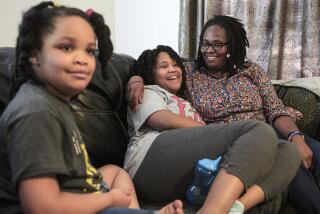Childhood-onset schizophrenia remains a mystery
So rare is the child form of schizophrenia, it has taken researchers at the National Institute of Mental Health 18 years to diagnosis and collect data on 110 children.
“We are trying to understand schizophrenia in a comprehensive way,” says Dr. Nitin Gogtay, a researcher involved with the project in Bethesda, Md. “We see the illness in a very pure form. At that age, there are no confounding factors, like alcohol or drug abuse. We feel a lot of answers will come out of this study.”
The study, the largest of its kind worldwide, has already yielded clues about the disease -- the most severe mental illness. Although schizophrenia afflicts about 1% of adults, it occurs in about one of every 30,000 to 50,000 children 13 and under. The causes of the disease are a mystery, although genes are known to play a role. In young children, a brain injury at or near the time of birth may contribute to its onset.
Brain scans of the children in the study, who are examined every two years, show a unique pattern that involves the loss of gray matter as well as deficits in white matter, Gogtay says. Gray matter contains nerve cell bodies while white matter contains filaments that extend from the cell bodies to carry messages. By the time these children reach adult age, however, the pattern of loss changes and appears as classic adult schizophrenia.
The study also involves comparing the children to their healthy siblings because siblings share 50% of genes. This research has shown that even healthy siblings, who have had never had symptoms of schizophrenia or taken medications for mental illness, have some loss of gray matter in their brains -- similar to the afflicted sibling. But by the time the healthy siblings turn 20, their brains appear normal on scans, Gogtay says.
The study has also demonstrated the difficulty of diagnosing a child with schizophrenia. Children are entered into the study based on input from the child’s doctors, parents and teachers describing symptoms that are highly suggestive of schizophrenia. The children are then admitted to a special ward at the National Institute of Mental Health where they remain for weeks or months.
In 30% of cases, children are diagnosed with something other than schizophrenia.
“They have bipolar disorder, depression or severe behavioral problems,” Gogtay says. “We have followed these children in which we have ruled out schizophrenia, and not one of them has been diagnosed with schizophrenia.”
One unique aspect of the study is that the children are weaned off all medication and are observed for up to three weeks without medication to arrive at a more accurate diagnosis. Under most insurance coverage, doctors are not allowed to undertake a “medication wash-out.”
The treatment of young children with the disease remains puzzling. As for the prognoses, doctors use terms like “guarded” and “painful.” Like adults, children with schizophrenia have auditory and visual hallucinations, disordered thinking and disruptive behavior.
“When you’re diagnosed early, one of the best hopes is that the diagnosis is not accurate,” says Dr. Louis Kraus, a member of the American Psychiatric Assn.’s council on children, adolescents and their families and chief of child psychiatry at Rush Sonia Shankman Orthogenic School in Chicago.
Of the 110 children, only two or three have gone to college, Gogtay says. The children who tend to do best are those who respond to clozapine, an anti-psychotic that is considered the “medication of last resort” because of its severe side effects.
“These kids are so severely ill, they tend to be medication, or treatment, refractory,” Gogtay says. “Most of them need some sort of support. Those with strong parent and community support do better.”
But such support is often lacking, Kraus says. The stigma of mental illnesses and the harsh and off-putting symptoms of schizophrenia can leave the child and family isolated from relatives, friends, neighbors and even the social and health professionals who are supposed to help them.
“When a child has cancer everyone is there to cook for you, support you, take care of things,” he says. “When mental illness touches a child, it’s such a difficult process. Every concept a parent has of the child growing up, going to school, going to a wedding, is thrown out the window. It’s a real mourning process, and often there are not a lot of people there to help you.”
More to Read
Sign up for Essential California
The most important California stories and recommendations in your inbox every morning.
You may occasionally receive promotional content from the Los Angeles Times.










